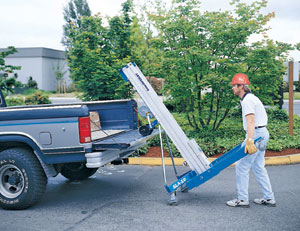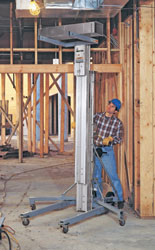A Lift for Every Load
Born of the need for workers to quickly and safely position a load overhead, material lifts are ideal tools to replace the heavy lifting previously done by hand. All material lifts are designed to do the same thing — allow an operator to lift, move and position heavy loads — but they are not created equal. Choosing the right material lift to best suit your needs can be simple, if you ask the right questions and do your homework.
Portable Productivity
“Material lifts can be used in thousands of applications in hundreds of industries,” says Kim Williams, product manager for Genie Industries. “One person can transport, set up and operate the majority of material lifts, so they save companies a lot of money on manual labor costs, and jobs get done more quickly.”
Most material lifts lift anywhere from 300 to 1,000 lbs, depending on the model, to heights ranging from 5 ft to just more than 26 ft. Common applications for material lifts include: shipping and receiving; moving office equipment; transporting appliances; HVAC and electrical installation and repair; installing ceiling and wall appliances; stocking shelves and order picking; truck loading and unloading; indoor and outdoor facility maintenance; handling cement bags; lifting and moving automotive parts; record storage and retrieval; and lifting lighting, sound systems and scenery.
These portable lift platforms are designed to work in most construction and industrial workspaces, including manufacturing and warehouse facilities, but they are also popular in retail and grocery stores, schools and universities and home improvement projects, as well as theatrical productions and entertainment events.
Lifting Made Easy
“In today’s market, there is a lift for every load. Customers can choose from a variety of options to configure the exact material lift for their worksite,” Williams says.

Standard and straddle base material lifts come standard with rear non-marking tires and front-swivel non-marking casters to prevent marking or damaging floors. Counterweight models are designed with rear-swivel casters and fixed front wheels.
The next option to consider for your material lift is a manually operated one-speed or two-speed winch. Some manufacturers offer an electric winch system option to lift and lower your loads faster. Other convenience options include a built-in stair above the rear tires for easy handling over stairs and curbs. Another accessory to consider is an attached aluminum ladder to access lifting and installation tasks.
“How customers intend to use a material lift dictates the options and attachments from which to choose,” says Williams. “With so many choices, a material lift can be customized to match an application.”
“Material lift manufacturers also offer a multitude of load handling attachments,” says Dennis McAuliffe of Powerlift Corp., a material lift dealer located in Newington, Va. “Some of the most common attachments customers choose include standard forks, adjustable forks, flat forks, fork extensions, load platforms, booms and pipe cradles. Attachments make these lifts adaptable to fit a variety of applications.”
What You Need to Know
According to McAuliffe, to get the right material lift you need to be ready to answer three questions. How big is the object I am trying to lift? How heavy is the object? How high do I need to lift it?

Whether buying or renting a material lift, your dealer should ask qualifying questions to make sure you get the right material lift for your worksite, says McAuliffe. The first thing your dealer needs to understand is what your business does and what you need to accomplish with the lift.
“Dealers always need to think of the customer’s business first,” says McAuliffe. “We should be asking our customers lots of questions — like what their company does — to make sure we get the information we need to help them.”
Other questions your dealer should ask include:
- How often will you use the lift?
- If you are using the lift indoors, how big is the facility and how do you need the lift to function in the workspace?
- Does the lift need to move from site to site? If so, what vehicle will you use to transport the lift?
- Where will you store the lift?
“It is the dealer’s job to educate customers on what they need to know in order to match them up to the right lift and to help them select attachments and options that make the most sense,” says McAuliffe. “If a customer can tell me the dimensions and weight of the object, and where it needs to be installed, I can work with them to answer the rest of the questions.”
You need to go into the dealership armed with specific details about the worksite where the material lift will be working, says both Williams and McAuliffe. It is important to know the type of flooring or surface the lift will be operating on, the size of the doorways, the size of the aisles and passageways, the height of the loading dock and the distance the lift needs to transport each item.
The Bottom Line
Many factors are intricately involved when selecting a material lift, and none of the information should be overlooked.
“To be productive and profitable with a material lift, it’s important to get the right lift for the job,” says McAuliffe. “Both the dealer and the customer need to do their homework and make sure they are asking lots of questions.”
Amber Reed is a technical writer for Performance Marketing, based in Des Moines, Iowa.

Comments are closed here.